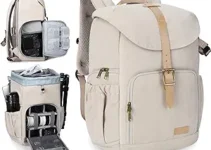Are you tired of carrying both a camera bag and a backpack on your photography adventures?
What if you could combine the two into one versatile solution? In this guide, we’ll explore how to transform a regular backpack into a functional and stylish camera bag.
Transforming your backpack into a camera bag is simpler than you might think.
With a few strategic modifications like adding padded inserts, dividers, and securing straps, your backpack can safely store your camera, lenses, and accessories. Say goodbye to bulky bags and hello to convenience!
Curious to learn more about maximizing your backpack’s potential as a camera bag?
Discover expert tips, innovative hacks, and step-by-step guides from seasoned photographers who have mastered this art.
Here can you buy just camera bag pads.
Get ready to revolutionize your photography gear setup and make every adventure a seamless and enjoyable experience.
What is backpack?
A backpack is a type of bag designed to be carried on one’s back, typically with two straps that go over the shoulders.
It’s commonly used for carrying items such as books, laptops, clothing, or camping gear.
Backpacks are popular among students, travelers, hikers, and commuters due to their convenience and ability to distribute weight evenly.
They come in various sizes, styles, and materials, ranging from small daypacks to large hiking packs.
Modern backpacks often feature padded straps and back panels for comfort, multiple compartments for organization, and sometimes specialized features like hydration systems or laptop sleeves.
Overall, backpacks are versatile and practical accessories that make it easier to transport belongings while keeping hands free.
They’re widely used in daily life, outdoor activities, and travel due to their functionality and ergonomic design.
Is it a good idea to turn a backpack into a camera bag?
Turning a backpack into a camera bag can be a good idea depending on your needs and the type of backpack you have.
Here, how to make a bean bag for camera support?
Here are some considerations:
- Protection: Camera equipment needs sufficient padding and protection from bumps and shocks. Ensure your backpack has enough padding or consider adding padded inserts to protect your gear.
- Accessibility: Camera bags often have quick-access compartments for easy retrieval of equipment. Modify your backpack to have similar features for convenient access to your camera, lenses, and accessories.
- Organization: Camera bags typically have compartments and dividers for organizing different gear. You may need to add dividers or pouches to your backpack to keep your camera equipment organized and prevent items from shifting.
- Comfort: Consider the weight of your camera gear and how comfortable the backpack is for carrying that weight over extended periods.
- Security: Ensure your modified backpack has features like locking zippers or hidden pockets to secure your expensive camera gear.
Ultimately, with the right modifications, a backpack can be a cost-effective and practical alternative to a dedicated camera bag.
How to turn a regular backpack into a camera bag?
To turn a regular backpack into a camera bag, follow these steps:
- Select the Right Backpack: Choose a backpack that is sturdy, has enough space for your camera gear, and can be easily modified. Look for one with a durable exterior and padding or compartments that can be customized.
- Add Padding and Protection: Line the interior of the backpack with soft, padded material like foam or fleece to protect your camera and lenses from bumps and shocks. You can use pre-cut foam inserts or customize padding using foam sheets.
- Create Compartments: Use dividers or pouches to create separate compartments for your camera body, lenses, accessories, and other equipment. Secure these dividers in place using Velcro or adhesive strips.
- Ensure Accessibility: Arrange your gear in a way that allows for easy access. Place frequently used items in easily reachable compartments.
- Add Security Features: Consider adding locking zippers or hidden pockets for added security when carrying expensive camera gear.
- Test and Adjust: Once you’ve made the modifications, test the backpack with your camera gear to ensure everything fits well and is adequately protected. Make any necessary adjustments for comfort and functionality.
By following these steps, you can effectively transform a regular backpack into a functional and protective camera bag.
Here, how to remove mold from camera bag?
Can I use a backpack as a camera bag?
Yes, you can use a backpack as a camera bag with some modifications and considerations.
While a dedicated camera bag offers specific features tailored for camera equipment, a well-chosen backpack can serve as a versatile alternative.
Here’s how:
- Padding and Protection: Ensure the backpack has adequate padding to protect your camera gear from impacts and shocks. Consider adding foam inserts or padded dividers to create compartments for your camera body, lenses, and accessories.
- Organization: Use pouches, dividers, or small bags to keep your gear organized and prevent items from shifting during transit. Arrange your equipment strategically for easy access.
- Accessibility: Choose a backpack with multiple compartments and quick-access pockets for convenient retrieval of frequently used items like your camera body or favorite lens.
- Comfort and Fit: Ensure the backpack is comfortable to carry, especially if you have a lot of gear. Look for padded straps, a supportive back panel, and adjustable features for a customized fit.
- Security: Consider adding features like locking zippers or hidden compartments to enhance security and protect your valuable camera gear.
With these modifications and considerations, a backpack can effectively function as a camera bag, providing protection, organization, and versatility for your photography needs.
Here, how to clean lowepro camera bag?
What can I use if I don’t have a camera bag?
If you don’t have a camera bag, you can use alternative options to carry your camera gear safely and conveniently:
- Padded Inserts or Wraps: Use padded inserts or wraps designed specifically for camera gear. These can be placed inside a regular backpack or bag to provide protection and organization for your equipment.
- Pouches or Cases: Use individual pouches or small cases for each piece of camera gear, such as your camera body, lenses, and accessories. This helps protect them from scratches and bumps while keeping them organized.
- DIY Padding: Create DIY padding using soft materials like foam or fleece. Wrap your camera and lenses in these materials before placing them in a regular bag for added protection.
- Clothing: Use soft clothing items like scarves, t-shirts, or socks to wrap around your camera and lenses for temporary protection when transporting them in a non-padded bag.
- Strategic Packing: Pack your camera gear in the center of a bag surrounded by soft items like clothing or towels to cushion them from impacts.
While a dedicated camera bag offers specialized features, these alternatives can provide temporary solutions for safely transporting your camera gear when a camera bag is not available.
How to store a camera in a normal backpack?
Storing a camera in a normal backpack requires careful consideration to ensure its safety and protection.
Here’s how to do it effectively:
- Use Padded Inserts or Wraps: Place your camera body and lenses in padded inserts or wraps designed for camera gear. These provide cushioning and protection against bumps and scratches.
- Organize Carefully: Arrange your camera gear in the center of the backpack to minimize movement and potential impacts. Place larger items at the bottom and lighter accessories on top.
- Protective Pockets or Compartments: Utilize any built-in pockets or compartments in the backpack for storing smaller accessories like memory cards, batteries, and lens caps. Ensure these compartments are padded or have soft lining.
- Secure Straps: Use the backpack’s straps to secure your camera gear in place and prevent shifting during movement. Avoid overpacking to maintain space and prevent excessive pressure on your equipment.
- Consider Weather Protection: If your backpack is not waterproof, use a rain cover or pack your camera gear in waterproof bags to protect it from moisture and weather conditions.
By following these steps, you can safely store your camera in a normal backpack while providing adequate protection against damage.
How to turn a backpack into a camera bag? 7 steps revealed
Step 1: Choose the Right Backpack
Select a sturdy backpack that can comfortably accommodate your camera gear.
Look for a backpack with a durable exterior, ample space, and adjustable straps for a customized fit.
Consider the type of photography you do and the amount of gear you typically carry to ensure the backpack’s size and design meet your needs.
Step 2: Add Padding and Protection
Line the interior of the backpack with soft, padded material to create a protective layer for your camera equipment.
You can use foam inserts, padded dividers, or custom-cut foam sheets to cushion your camera body, lenses, and accessories. Ensure that the padding is thick enough to absorb shocks and prevent damage during transit.
Step 3: Create Compartments
Use dividers or pouches to create separate compartments within the backpack for organizing your camera gear.
Arrange the compartments strategically based on the size and shape of your equipment.
Place larger items like camera bodies or telephoto lenses at the bottom and smaller accessories like filters or memory cards in the upper compartments for easy access.
Step 4: Ensure Accessibility
Designate specific pockets or compartments for frequently used items such as your camera body, primary lens, and extra batteries.
Ensure these compartments are easily accessible without having to rummage through the entire backpack.
Consider adding zippered pockets or Velcro closures for added security and convenience.
Step 5: Add Security Features
Incorporate security features such as locking zippers or hidden pockets to safeguard your valuable camera gear.
This helps prevent theft or unauthorized access to your equipment, especially when traveling or in crowded areas.
Choose backpacks with reinforced stitching and durable materials for added durability and security.
Step 6: Test and Adjust
Once you’ve made the necessary modifications, test the backpack with your camera gear to ensure everything fits securely and is well-protected.
Adjust the padding, dividers, and compartment layout as needed to optimize organization and comfort.
Walk around with the loaded backpack to assess its weight distribution and adjust straps for a comfortable carry.
Step 7: Customize for Comfort
Consider adding ergonomic features such as padded shoulder straps, a ventilated back panel, and a waist belt to distribute the weight of the backpack evenly and reduce strain on your shoulders and back.
Customize the fit of the backpack to your body shape for a comfortable and ergonomic carrying experience, especially during long photo shoots or hikes.
By following these seven steps, you can effectively transform a regular backpack into a functional and protective camera bag tailored to your photography needs.
How to turn a backpack into a camera bag without
To turn a regular backpack into a camera bag without making permanent modifications, follow these steps:
Here, can a camera bag be a carry on?
- Use Padded Inserts: Insert padded camera gear inserts or wraps into the backpack to cushion your equipment.
- Organize Strategically: Arrange your camera, lenses, and accessories in the center of the backpack to minimize movement.
- Protective Layers: Wrap sensitive items like lenses in soft clothing or microfiber towels for extra protection.
- Utilize Compartments: Utilize existing pockets and compartments for organizing smaller accessories like memory cards and batteries.
- Secure Straps: Use the backpack’s straps to secure your camera gear and prevent shifting during movement.
- Weather Protection: Consider using a waterproof cover or packing your gear in waterproof bags if your backpack is not water-resistant.
- Regular Maintenance: Regularly check and clean your backpack to ensure it remains suitable for carrying camera equipment.
By following these steps, you can effectively use a regular backpack as a temporary camera bag without making permanent alterations.
Conclusion
In conclusion, transforming a backpack into a camera bag involves adding padding, organizing compartments strategically, utilizing protective layers, securing straps, considering weather protection, and maintaining regular upkeep.
These steps ensure that your backpack serves as a functional and protective storage solution for your camera gear.
Camera insert for backpack
| Image | Product | Details | Price |
|---|---|---|---|
 |
Neewer NW140S Waterproof Camera and Lens Storage Carrying | Holds and protects 1 DSLR/Mirrorless camera body, 1-4 lenses or additional accessories | Check Price |
 |
Camera Insert Bag,Backpack Inner Camera Padded Organizer Case | Adjustable inner bladder partition.The detachable partition board is attached | Check Price |
 |
BOMKEE Camera Inserts Protective Bag Padded Insert Camer | This camera bag insert made from high density nylon fabric, anti-static composite | Check Price |






